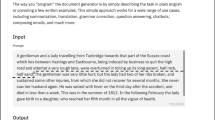Abstract
Two new books—Creating Language: Integrating Evolution, Acquisition, and Processing by Morten H. Christiansen and Nick Chater, and Why Only Us: Language and Evolution by Robert C. Berwick and Noam Chomsky—present a good opportunity to assess the state of the debate about whether or not language was made possible by language-specific adaptations for syntax. Berwick and Chomsky argue yes: language was made possible by a single change to the computation Merge. Christiansen and Chater argue no: our syntactic abilities developed on the back of natural selection for general-purpose sequence learning mechanisms. While Christiansen and Chater’s book testifies to impressive developments in constructivist approaches to language development, it’s not obvious that it has the resources to explain the hierarchical nature of syntactic binding. Despite this, the views have much in common.
Similar content being viewed by others
Notes
Note that while BC’s formulation of the language of thought claim sounds Fodorian (e.g., Fodor 2008), they do not cite Fodor here. Moreover, their criteria for concept possession are presumably not like Fodor’s since, on Fodor’s view animals also have a language of thought. Sadly, BC do not say enough about what they think concept possession is to clarify this difference.
Thanks to an anonymous reviewer for this point.
In discussion of Kanzi’s abilities, one should always be wary of anthropomorphism—but a compelling video illustrating his comprehension of novel sentences can be found here: https://www.youtube.com/watch?v=2Dhc2zePJFE.
CC also offer arguments against gradualist versions of UG, but for reasons of space I will not discuss them here.
In an earlier version of Chomsky’s minimalist UG (Hauser et al. 2002), recursion was thought to play the same role that Merge does for BC. Despite the obvious continuity between Hauser et al. (2002) and BC, in BC it is not entirely clear whether Merge is identical to recursion, or just a necessary precondition for it.
I owe this point to an anonymous reviewer.
References
Chomsky N (1965) Aspects of the theory of syntax. MIT Press, Cambridge
Chomsky N (1995) The minimalist program. MIT Press, Cambridge
Davidson D (1982) Rational animals. Dialectica 36(4):317–327
de Villiers JG, Pyers JE (2002) Complements to cognition: a longitudinal study of the relationship between complex syntax and false-belief-understanding. Cogn Dev 17(1):1037–1060
Fodor J (2008) LOT 2: the language of thought revisited. OUP, Oxford
Frank SL, Bod R, Christiansen MH (2012) How hierarchical is language use? Proc R Soc B 279:4522–4531
Hauser MD, Chomsky N, Fitch WT (2002) The faculty of language: what is it, who has it, and how did it evolve? Science 298(5598):1569–1579
Hobaiter C, Byrne RW (2014) The meanings of chimpanzee gestures. Curr Biol 24(14):1596–1600
Jackendoff R (2002) Foundation of language: brain, meaning, grammar, evolution. OUP, New York
Kidd E, Bavin EL (2002) English-speaking children’s comprehension of relative clauses: evidence for general-cognitive and language-specific constraints on development. J Psycholinguist Res 31(6):599–617
Krause J, Lalueza-Fox C, Orlando L, Enard W, Green RE, Burbano HA, Hublin JJ, Hänni C, Fortea J, De La Rasilla M, Bertranpetit J (2007) The derived FOXP2 variant of modern humans was shared with Neandertals. Curr Biol 17(21):1908–1912
Lohmann H, Tomasello M (2003) The role of language in the development of false belief understanding: a training study. Child Dev 74(4):1130–1144
Maricic T, Günther V, Georgiev O, Gehre S, Ćurlin M, Schreiweis C, Naumann R, Burbano HA, Meyer M, Lalueza-Fox C, de la Rasilla M (2013) A recent evolutionary change affects a regulatory element in the human FOXP2 gene. Mol Biol Evol 30(4):844–852
Milligan K, Astington JW, Dack LA (2007) Language and theory of mind: meta-analysis of the relation between language ability and false-belief understanding. Child Dev 78(2):622–646
Moore R (2014) Ape gestures: interpreting chimpanzee and bonobo minds. Curr Biol 24(14):R645–R647
Moore R (2016) Meaning and ostension in great ape gestural communication. Anim Cogn 19(1):223–231
Pinker S, Bloom P (1990) Natural language and natural selection. Behav Brain Sci 13(04):707–727
Progovac L (2015) Evolutionary syntax. OUP, Oxford
Pullum GK, Scholz BC (2005) Contrasting applications of logic in natural language syntactic description. Logic, methodology and philosophy of science. In: Proceedings of the twelfth international congress, pp 481–503
Rivas E (2005) Recent use of signs by chimpanzees (Pan troglodytes) in interactions with humans. J Comp Psychol 119(4):404
Savage-Rumbaugh ES, Shanker S, Taylor TJ (1998) Apes, language, and the human mind. OUP, Oxford
Schreiweis C, Bornschein U, Burguière E, Kerimoglu C, Schreiter S, Dannemann M, Goyal S, Rea E, French CA, Puliyadi R, Groszer M (2014) Humanized Foxp2 accelerates learning by enhancing transitions from declarative to procedural performance. PNAS 111(39):14253–14258
Truswell R (in press) Dendrophobia in bonobo comprehension of spoken English. Mind & Lang
Yang C (2013) Ontogeny and phylogeny of language. PNAS 110(16):6324–6327
Acknowledgements
For helpful comments on the first draft of this essay, I would like to think Cameron Buckner, Bryce Huebner, and one anonymous referee.
Author information
Authors and Affiliations
Corresponding author
Rights and permissions
About this article
Cite this article
Moore, R. The evolution of syntactic structure. Biol Philos 32, 599–613 (2017). https://doi.org/10.1007/s10539-017-9571-5
Received:
Accepted:
Published:
Issue Date:
DOI: https://doi.org/10.1007/s10539-017-9571-5




